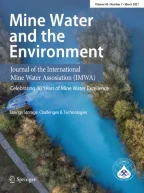Abstract
To ensure safe mining of the no. 2 coal seam in the Pingdingshan No. 10 coal mine, three methods (analogue, big well, and numerical simulation) were used to forecast mine water inflow and their performance. The big well method predicted the largest water inflow: 233.8 m3/h in the −230 m level and 281.1 m3/h in the −300 m level. The numerical simulation predicted the least inflow, 205.7 and 228.6 m3/h respectively for the 230 and −300 m levels; this was closest to the measured values. Based on this work, it appears that combining numerical simulations with other methods are a good way to accurately forecast mine water inflow.
Zusammenfassung
Um den sicheren Abbau des Flözes Nr. 2 im Kohlebergwerk Pingdingshan Nr. 10 zu ermöglichen, wurden drei Methoden (Analogieschluss, Big-Well-Methode und numerische Simulation) für die Vorhersage des Zustroms an Grubenwasser benutzt und hinsichtlich ihrer Leistung verglichen. Die Big-Well-Methode sagte die größten Zuflussmengen vorher: 233.8 m3/h auf dem −230 m Niveau und 281.1 m3/h auf dem −300 m Niveau. Die numerische Simulation prognostizierte die geringsten Zuflussmengen, 205.7 m3/h auf dem −230 m Niveau und 228.6 m3/h auf dem −300 m Niveau. Diese Werte kamen den gemessenen am nächsten. Basierend auf den durchgeführten Arbeiten erscheint das Kombinieren numerischer Simulationen mit anderen Methoden eine gute Möglichkeit, den Grubenwasserzustrom zutreffend vorherzusagen.
Resumen
Para volver segura la minería en la veta de carbón no. 2 en la mina de carbón Pingdingshan, tres métodos (análogo, big well y simulación numérica) fueron usados para predecir la afluencia de agua de mina y sus comportamientos. El método big well predijo la mayor afluencia de agua: 233.8 m3/h en el nivel −230 m y 281.1 m3/h en el nivel −300 m. La simulación numérica predijo la menor afluencia, 205.7 m3/h y 228.6 m3/h respectivamente para los niveles de −230 y −300 m; esto último es muy cercano a los valores medidos. Este trabajo indica que las simulaciones numéricas combinadas con otros métodos son un buen camino pra predecir en forma precisa las afluencias de agua de mina.
多种方法预测平顶山十矿涌水量(中国)
为保证平顶山十矿2号煤层安全开采,使用三种方法(类比法、大井法和数值模拟)预测矿井涌水量。大井法预测 −230 m水平和 −300 m水平最大涌水量分别为 233.8 m3/h 与 281.1 m3/h。数值模拟预测最小涌水量与实测涌水量接近,−230 m 水平与 −300 m 水平预测涌水量分别为 205.7 m3/h 与 228.6 m3/h。数值模拟与其他方法相结合能够更可靠地预测矿井涌水量。
Explore related subjects
Discover the latest articles, news and stories from top researchers in related subjects.References
Adhikary D (2012) Numerical simulation of mine water inflow. In: Proceedings of international society for rock mechanics, Stockholm, Sweden. https://www.onepetro.org/conference-paper/ISRM-EUROCK-2012-078
Chen MZ, Liu SC, Yang GY (2009) The development of mining water inflow predict method. Chin J Eng Geophys 1:16 (in Chinese)
Cheng XB (2012) Parameter selection for prediction of water inflow using big well method. Coal 21:54–55 (in Chinese)
Dong D, Sun W, Xi S (2012) Optimization of mine drainage capacity using FEFLOW for the No. 14 coal seam of China’s Linnancang coal mine. Mine Water Environ 31:353–360
Harbaugh AW (2005) MODFLOW-2005, the US Geological Survey modular ground-water model: the ground-water flow process. USGS, Reston
Hua JM (2009) A question against the open well method prediction of mine water inflow. N China I Sci Technol 6:74–76 (in Chinese)
Hua JM (2010) Unsteady flow analytic method in mine inflow computation. Coal Geol China 21:38–40 (in Chinese)
Li GC (2013) Application of numerical simulation in coal mine water inflow calculation. Meitan Jishu/Coal Technol 32:115–117
Li L (2014) Application of numerical simulation in water inflow prediction of mine. Coal Min Technol 19:126–128 (in Chinese)
Lian H, Xia X, Xu B, Xu H (2014) Evaluation and applicability study on prediction methods of water inflow in mines. N China I Sci Technol 11:22–27 (in Chinese)
Niswonger RG, Panday S, Ibaraki M (2011) MODFLOW-NWT, a Newton Formulation for MODFLOW-2005. USGS Tech Methods 6:A37
Peng Z, Yajun S (2012) Application of analytical method for water flow prediction of draining with mining under safe water pressure of aquifer. Zhongzhou Coal 4:10 (in Chinese)
Shao AJ, Meng QX, Wang SW, Liu Y (2014a) Prediction of mine inrush water based on BP neural network method. Adv Mat Res 989:1814–1820
Shao AJ, Wang S, Yang H, Liu Y (2014b) Numerical simulation and inflow prediction by the outflow test of coal mine. In: Proceedings annual international mine water association conference, Xuzhou, China, pp 31–37
Wang HF, Anderson MP (1995) Introduction to groundwater modeling: finite difference and finite element methods. Academic Press, San Diego
Wenfu W, Liwen C (2011) Comparative analysis for analogue method and analytical method in prediction of water inflow in some coal mine. China Coal 7:12 (in Chinese)
Wu Q, Cui FP, Zhao SQ, Liu SJ, Zeng YF, Gu YW (2013) Type classification and main characteristics of mine water disasters. J China Coal Soc 38:561–565 (in Chinese)
Acknowledgments
This study was financially supported by the Fundamental Research Funds for the Central Universities (2009QD03), which we gratefully acknowledge.
Author information
Authors and Affiliations
Corresponding authors
Rights and permissions
About this article
Cite this article
Zhang, K., Cao, B., Lin, G. et al. Using Multiple Methods to Predict Mine Water Inflow in the Pingdingshan No. 10 Coal Mine, China. Mine Water Environ 36, 154–160 (2017). https://doi.org/10.1007/s10230-015-0381-1
Received:
Accepted:
Published:
Issue Date:
DOI: https://doi.org/10.1007/s10230-015-0381-1
